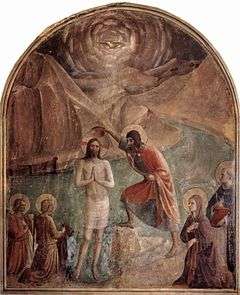Matthew 3:16
Matthew 3:16 is the sixteenth verse of the third chapter of the Gospel of Matthew in the New Testament. Jesus has just been baptized by John the Baptist and in this verse the Holy Spirit comes to him like a dove.
| Matthew 3:16 | |
|---|---|
← 3:15 3:17 → | |
 Fra Angelico's Baptism of Christ | |
| Book | Gospel of Matthew |
| Christian Bible part | New Testament |
Content
In the King James Version of the Bible the text reads:
- And Jesus, when he was baptized, went
- up straightway out of the water: and,
- lo, the heavens were opened unto him,
- and he saw the Spirit of God descending
- like a dove, and lighting upon him:
The World English Bible translates the passage as:
- Jesus, when he was baptized, went up
- directly from the water: and behold,
- the heavens were opened to him. He
- saw the Spirit of God descending
- as a dove, and coming on him.
For a collection of other versions see BibleHub Matthew 3:16.
Analysis
Gundry notes the emphasis the author of Matthew gives to how quickly Jesus gets out of water of the Jordan. An emphasis not found in Mark or Luke. Gundry believes this is because the baptism would traditionally have been followed by a confessing of sins and the author of Matthew wanted to be clear that Jesus, who had no sins, did not undergo this part of the ritual.[1]
France notes that the "heavens were opened" echoes Ezekiel 1:1. France feels that this might thus represent the return of the gift of prophecy to the earth.[2] Hill notes that some early manuscripts have "opened up to him" rather than just "opened up." This makes the event a more private one, and helps explain why the crowds depicted as watching the baptism in Luke do not become aware of Jesus' status.[3]
The dove imagery in this passage, and in the corresponding verse in Luke, is a well known one. Based on this verse the dove has long been a symbol for the Holy Spirit in Christian art. France notes that the wording in Matthew is vague, the Spirit could be descending in the shape of a dove or it could be descending in the manner of the dove. Luke is explicit that it is in the shape of a dove, and most readers accept this meaning.[4]
This is the only event where the Spirit is described as taking such a form. There was a wide array of symbolism attached to the dove at the time the gospel was written. Albright and Mann note that in Hosea 7:11 and 11:11 the dove is a symbol for the nation of Israel.[5] Clarke feels that this verse links to both Genesis 1:2, with the image of God hovering over the water, and to Genesis 8 where Noah sends a dove out over the water to search for land. Clarke feels the symbolism of the dove was thus one of creation with Jesus' baptism symbolically the rebirth of the world.[6] In the Greco-Roman world the dove was at the time seen as a symbol of lust, as it was the symbol of Aphrodite. It was also, however, a symbol of purity due to its whiteness and the belief that it was without bile.
The spirit "coming on him" may be a reference to a series of prophecies in Isaiah (11:2, 42:1, 61:1) where the spirit is described as being placed on God's chosen one. France notes that this doesn't mean the Holy Spirit has been absent from Jesus beforehand, as Matthew 1 makes clear it has been present since his conception.[7]
Textual witnesses
Some early manuscripts containing the text of this verse are:
- Papyrus Oxyrhynchus 405 (~ 200)[8]
- Papyrus 101 (3rd century)[9][10]
- Codex Vaticanus (~325–350)
- Codex Sinaiticus (~330–360)
- Codex Washingtonianus (~400)
- Codex Bezae (~400)
- Codex Ephraemi Rescriptus (~450)
References
- Gundry, Robert H. Matthew a Commentary on his Literary and Theological Art. Grand Rapids: William B. Eerdmans Publishing Company, 1982.
- France, R.T. The Gospel According to Matthew: an Introduction and Commentary. Leicester: Inter-Varsity, 1985.
- Hill, David. The Gospel of Matthew. Grand Rapids: Eerdmans, 1981
- France, R.T. The Gospel According to Matthew: an Introduction and Commentary. Leicester: Inter-Varsity, 1985.
- Albright, W.F. and C.S. Mann. "Matthew." The Anchor Bible Series. New York: Doubleday & Company, 1971.
- Clarke, Howard W. The Gospel of Matthew and its Readers: A Historical Introduction to the First Gospel. Bloomington: Indiana University Press, 2003.
- France, R.T.. The Gospel of Matthew. Wm. B. Eerdmans Publishing, 2007 pg. 121
- Egypt Exploration Fund (1903). Grenfell, Bernard P.; Hunt, Arthur S. (eds.). The Oxyrhynchus Papyri. 3. Oxford. p. 10.
405 consists of seven fragments written in a small neat uncial hand, which is not later than the first half of the third century, and might be as old as the later part of the second.
- Thomas, J. David. The Oxyrhynchus Papyri LXIV (London: 1997), pp. 2–4.
- "Liste Handschriften". Münster: Institute for New Testament Textual Research. Retrieved 27 August 2011.
| Preceded by Matthew 3:15 |
Gospel of Matthew Chapter 3 |
Succeeded by Matthew 3:17 |